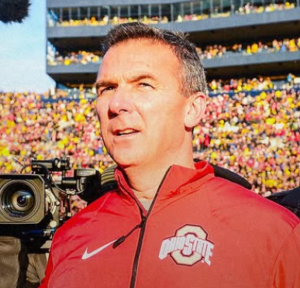Urban Meyer’s candid assessment of the SEC and Big Ten underscores a pivotal moment in college football history
While the SEC’s dominance defined the sport for over a decade, the Big Ten’s recent rise signals a shift in power.
With its strategic expansion, improved recruiting, and commitment to excellence, the Big Ten is poised to challenge the SEC for the title of college football’s premier conference.
Another factor contributing to the Big Ten’s rise is the stability and quality of its coaching ranks. Programs like Michigan and Ohio State benefit from the long-term leadership of Harbaugh and Ryan Day, respectively.
This consistency allows teams to build cohesive systems and sustain success over time.
In contrast, the SEC has experienced significant turnover among its coaching ranks, with several programs undergoing transitions that have hindered their ability to compete at the highest level.

Also Read: Urban Meyer: Wife Shelley Meyer, Married Life, Children, Career and More
Table of Contents
Urban Meyer: Legacy of Dominance in College Football
Urban Meyer is one of the most successful figures in college football history, achieving greatness with programs like the Florida Gators and the Ohio State Buckeyes.1
His coaching résumé boasts three national championships, a testament to his ability to craft winning teams.
However, Meyer’s career also offered him a unique perspective on the differences between two of college football’s most prominent conferences: the Southeastern Conference (SEC) and the Big Ten.
During his time as head coach at Florida (2005–2010), Meyer experienced firsthand the SEC’s unparalleled dominance. The conference was renowned for its speed, athleticism, and depth, which consistently set it apart from others.
Meyer’s Gators teams were stacked with talent, featuring players like Tim Tebow and Percy Harvin, who exemplified the high-level performance the SEC had become synonymous with.
When Meyer transitioned to the Big Ten in 2012 to coach the Ohio State Buckeyes, the disparity between the two conferences was stark. As he explained in a recent appearance on The Triple Option, “The speed on the field didn’t even look the same.” This gap in talent and overall competitiveness fueled the SEC’s reputation as the pinnacle of college football.
Lou Holtz’s championship advice 🏆 #CFBPlayoff
@Wendys #WendysPartner pic.twitter.com/ItLCtPlHRu— Urban Meyer (@CoachUrbanMeyer) January 1, 2025
The Big Ten’s Evolution: Closing the Gap
In the years since Meyer joined the Big Ten, the conference has undergone a remarkable transformation. The addition of powerhouse programs like Oregon, Washington, UCLA, and USC has infused the league with new energy and talent.
Beyond expansion, Big Ten schools have significantly upped their game in recruiting, player development, and financial investment in football programs.
Meyer pointed out the efforts of top-tier Big Ten programs such as Michigan and Ohio State. Michigan’s resurgence under head coach Jim Harbaugh, combined with Ohio State’s consistent success, has elevated the conference’s national standing.
“The Wolverines last year, the Buckeyes this year,” Meyer noted, emphasizing their competitiveness on a national level.

Urban Meyer: The SEC’s Struggles in 2024
While the Big Ten has been on the rise, the SEC has faced an uncharacteristic downturn in 2024.2
Traditional powers like Alabama and LSU have shown vulnerabilities, and other programs, such as South Carolina and Ole Miss, have struggled to maintain relevance.
This has led to debates about the SEC’s overall strength and its ability to maintain its status as the nation’s top football conference.
Meyer acknowledged this shift, saying, “There’s a good argument now” for the Big Ten surpassing the SEC. This sentiment has gained traction among analysts and fans alike, particularly as Big Ten teams continue to shine in marquee matchups.
Expansion Wars: Big Ten’s Strategic Growth
The Big Ten’s addition of West Coast programs such as UCLA and USC was a masterstroke in conference expansion.
These schools not only bring rich football traditions but also expand the Big Ten’s geographical footprint and television market. Oregon and Washington, known for their high-octane offenses and competitive histories, further bolster the conference’s depth.
This expansion strategy contrasts with the SEC’s approach, which has largely relied on its existing dominance to attract top-tier recruits and maintain competitive advantage. However, the Big Ten’s proactive moves have positioned it as a serious challenger to the SEC’s supremacy.
The Role of Recruiting in Shaping Conference Power
Recruiting is the lifeblood of college football success, and the Big Ten’s commitment to improving in this area has been a game-changer.
Programs like Ohio State and Michigan have consistently landed top-10 recruiting classes, while newcomers like Oregon have brought a wealth of talent from the West Coast.
Meyer emphasized the importance of this trend, noting that “people have really committed in the Big Ten.” This dedication to recruiting not only levels the playing field but also ensures that the conference will remain competitive in the long term.
Shifting Perceptions: Media and Fan Debates
- The perceived decline of the SEC and the rise of the Big Ten have sparked heated debates among media pundits and fans.
- Meyer referenced criticism directed at ESPN commentators who argued that South Carolina and Ole Miss deserved playoff consideration over certain Big Ten teams.
- “Not so fast,” Meyer countered, suggesting that the Big Ten’s top programs are now deserving of equal, if not greater, respect.
- The College Football Playoff’s impending expansion to 12 teams will provide a clearer picture of conference strength.
- Under the new format, more Big Ten and SEC teams will have opportunities to compete on the national stage, potentially redefining the hierarchy of college football.
- Meyer’s comments hint at a future where Big Ten teams, bolstered by their recruiting and strategic growth, could outshine their SEC counterparts in postseason play.
- This shift would mark a seismic change in the landscape of college football.

Urban Meyer’s Unique Perspective
From SEC to Big Ten
Urban Meyer’s career trajectory gives him a rare vantage point to assess the two conferences.3
Having won championships in the SEC and later leading Ohio State to national prominence in the Big Ten, Meyer understands the cultural and structural differences that define each league.
His comments reflect both his deep respect for the SEC’s past dominance and his recognition of the Big Ten’s potential to become college football’s premier conference.
Despite the Big Ten’s rise, challenges remain. Integrating new programs like Oregon and USC into the conference will require careful planning, particularly regarding travel logistics and scheduling. Additionally, maintaining parity across the league will be crucial to sustaining its upward trajectory.
Meanwhile, the SEC must address its current struggles and reaffirm its position as college football’s gold standard. This will likely involve strategic adjustments in recruiting, coaching, and overall program management.
A New Era of College Football Rivalry
The evolving dynamic between the SEC and Big Ten represents a new chapter in college football. As both conferences vie for supremacy, fans can look forward to more high-stakes matchups and intensified rivalries.
Whether through regular-season games, bowl appearances, or playoff battles, the competition between these two leagues promises to shape the future of the sport.
The Big Ten’s commitment to football excellence extends beyond recruiting and coaching. The conference’s programs have invested heavily in state-of-the-art facilities, sports science, and player wellness initiatives.
These investments not only attract elite recruits but also enhance player development and overall team performance.
Meyer highlighted how these advancements have contributed to the Big Ten’s rise, creating an environment where athletes can thrive both on and off the field.

Also Read: Urban Meyer: Affair, Scandal, Relationship, Cheating Controversy And More
Urban Meyer: The Big Ten is Emerging as a Contender to the SEC
Urban Meyer, a renowned college football coach and analyst, has recently stirred discussions about the balance of power in college football.
Speaking on “The Triple Option” podcast, Meyer suggested that the Big Ten has closed the gap with the SEC this season.
His observations come as the Big Ten enjoys a particularly successful year, outperforming expectations and challenging the SEC’s longstanding dominance.
This shift prompts a deeper look into the factors contributing to the Big Ten’s rise and what it means for college football’s future.
The Big Ten’s Resurgence
This season has been a showcase of the Big Ten’s depth and competitiveness. As the College Football Playoff (CFP) semifinals approach, Big Ten teams such as Ohio State and Penn State remain in contention.
Notably, the Big Ten saw four teams—Ohio State, Penn State, Oregon, and Indiana—qualify for the playoff. By contrast, the SEC has only three teams—Texas, Georgia, and Tennessee—still standing.
The Big Ten’s broader success highlights its teams’ abilities to perform consistently against strong competition.
While the SEC has long been heralded as the gold standard in college football, this year’s results suggest a more balanced playing field.

Urban Meyer’s Recruiting: The Battle for Talent
One key factor in the Big Ten’s resurgence is its ability to attract top-tier recruits. Programs like Ohio State, Penn State, and Michigan have consistently landed highly rated players, rivaling SEC teams in recruiting battles.
As the Big Ten continues to invest in facilities and coaching, its appeal to recruits will only grow.
The Big Ten’s coaching talent has also been instrumental in its success. Coaches like Ryan Day (Ohio State), James Franklin (Penn State), and Kalen DeBoer (Indiana) have developed competitive programs capable of contending with the best in the SEC.
Their strategic acumen and player development skills have been game-changers for the conference.
Media Rights and Exposure
The Big Ten’s lucrative media rights deal has further enhanced its profile. With extensive television coverage and significant financial resources, the conference has been able to invest in its programs and expand its reach.
This increased visibility helps attract recruits and elevates the conference’s overall stature.
While the Big Ten has enjoyed a stellar season, sustaining this success will require continued effort. Consistency in recruiting, player development, and performance against top competition will be crucial.
If the Big Ten can maintain its upward trajectory, it may solidify its position as a true rival to the SEC.
View this post on Instagram
The SEC’s Path to Redemption
The SEC is unlikely to relinquish its status without a fight. Programs like Alabama and LSU will undoubtedly regroup and reassert themselves in the coming years.
The conference’s rich tradition and deep talent pool ensure it will remain a force in college football.
Urban Meyer’s assertion that the Big Ten has caught up to the SEC highlights a significant shift in college football.
This season’s results underscore the growing parity between the two conferences and suggest a more competitive future for the sport.
As the Big Ten continues to rise, fans can look forward to an era where the question of which conference reigns supreme is hotly debated and decided on the field.
Also Read: Ryan Day’s OSU Salary: How Much Does Ohio State’s Coach Earn?




